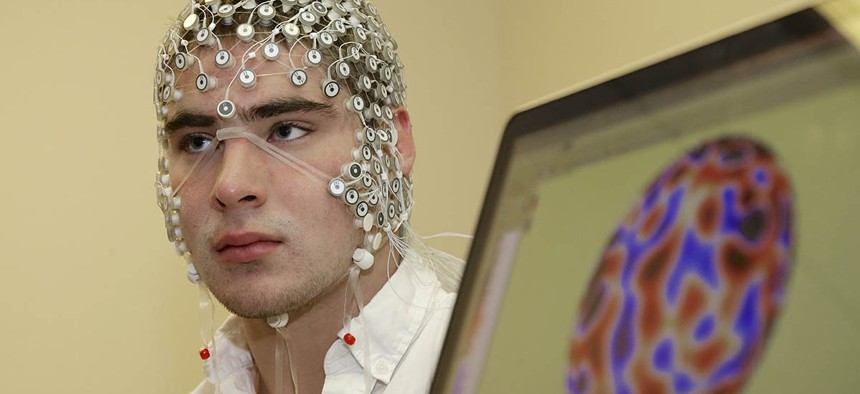It’s Now Possible To Telepathically Communicate with a Drone Swarm

In this May 31, 2013, photo, research assistant Kevin Real wears an EEG net for detecting brain activity which is hooked up to a monitor, at the University of Nebraska's Center for Brain, Biology and Behavior in Lincoln, Neb. Nati Harnik/AP
DARPA’s new research in brain-computer interfaces is allowing a pilot to control multiple simulated aircraft at once.
A person with a brain chip can now pilot a swarm of drones — or even advanced fighter jets, thanks to research funded by the U.S. military’s Defense Advanced Research Projects Agency, or DARPA.
The work builds on research from 2015, which allowed a paralyzed woman to steer a virtual F-35 Joint Strike Fighter with only a small, surgically-implantable microchip. On Thursday, agency officials announced that they had scaled up the technology to allow a user to steer multiple jets at once.
“As of today, signals from the brain can be used to command and control … not just one aircraft but three simultaneous types of aircraft,” said Justin Sanchez, who directs DARPA’s biological technology office, at the Agency’s 60th-anniversary event in Maryland.
More importantly, DARPA was able to improve the interaction between pilot and the simulated jet to allow the operator, a paralyzed man named Nathan, to not just send but receive signals from the craft.
“The signals from those aircraft can be delivered directly back to the brain so that the brain of that user [or pilot] can also perceive the environment,” said Sanchez. “It’s taken a number of years to try and figure this out.”
In essence, it’s the difference between having a brain joystick and having a real telepathic conversation with multiple jets or drones about what’s going on, what threats might be flying over the horizon, and what to do about them. “We’ve scaled it to three [aircraft], and have full sensory [signals] coming back. So you can have those other planes out in the environment and then be detecting something and send that signal back into the brain,” said Sanchez.
The experiment occured a “handful of months ago,” he said.
It’s another breakthrough in the rapidly advancing field of brain-computer interfaces, or BCIs, for a variety of purposes. The military has been leading interesting research in the field since at least 2007,. And in 2012, DARPA issued a $4 million grant to build a non-invasive “synthetic telepathy” interface by placing sensors close to the brain’s motor centers to pick up electrical signals — non-invasively, over the skin.
But the science has advanced rapidly in recent years, allowing for breakthroughs in brain-based communication, control of prosthetic limbs, and even memory repair.






